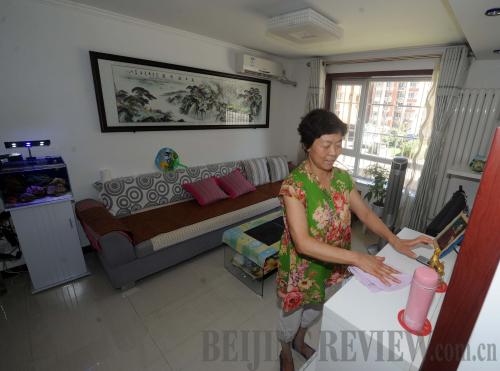|
 |
|
FRESH PAD: Huo Weiguo, a former shantytown resident in Beijing's Mentougou District, cleans her new home (GONG LEI) |
Although aging, Huo Qingguo is very content with her life, which was dramatically changed by a shantytown renovation project launched by the Beijing Municipal Government.
Not long ago, Huo moved into a new apartment in Shimenying Residential Community in Mentougou District, Beijing's western suburb. Her new home is four times the size of the old bungalow in which Huo's family had lived for more than two decades. In addition, the community has many public facilities close by, including a supermarket, a kindergarten and a primary school. Residents have also formed groups that meet regularly to engage in singing, dancing, fashion shows and other forms of entertainment and socializing.
"I don't want anything more than this. I just want to cherish life," Huo said.
Mentougou was once one of the five largest hard coal production areas in China. The district had many coal and limestone mines ranging from small to large. Since 2004, the district government has shut down 270 coal mines and many other polluting enterprises such as cement production plants in the region.
After the mines were closed up, many dilapidated houses built in the 1950s and 60s still stood there, among which was Huo's tiny bungalow of only 20 square meters. About 85,000 miners and farmers from 31,000 households were living in an area of waste from coal mining spanning 7 square km in Mentougou.
Due to land subsidence, the area was hazardous and not suitable for living. Pang Chengzhu, a retired coalminer, used to reside there. He said that walls in his room cracked because of slow sinking land there, which was caused by abandoned coalmines. Pang's family worried about their safety constantly.
The renovation project was started in Mentougou during 2009 and aimed to build apartment buildings with a total area of 2 million square meters within three years. Shantytown residents would be moved away from the wasteland around abandoned mines and into new residential quarters. By the end of 2012, 8,500 apartments had been given to relocated families.
Huo's bungalow was torn down. As compensation, her family was offered an apartment of about 60 square meters and 90,000 yuan ($14,754). Huo chose to decline the cash compensation for an additional 20 square meters of living space.
Huge benefits
Shantytown renovation projects have boosted the confidence of low-income residents, and enabled them to live a more dignified life, said Qi Ji, Vice Minister of Housing and Urban-Rural Development.
Previously, shantytown resident conversations with one another were often about negative topics, such as leaks in the roof, but nowadays—after moving into new homes—they are so happy that they are inviting all their friends to visit, Qi added.
Shantytown renovation pertains to both people's livelihood and development, said Premier Li Keqiang during a tour of Beiliang shantytown area in Baotou City, north China's Inner Mongolia Autonomous Region, in February.
Li said that shantytown renovation is able to significantly boost domestic demand while shrinking the income gap. Cities should not have high-rise apartment complexes on one side and shantytowns on the other. "If this disparity is not eliminated, the quality of urbanization will be compromised," he added.
In addition, shantytown renovation can also have an environmental benefit. Premier Li said that the effort is effective in lowering coal consumption and in turn reduce pollution, as shantytown residents often burn coal for cooking and heating.
In recent years, shantytown renovation projects have fundamentally changed living conditions among tens of thousands of people from more than 12 million households all over the country. Li called on local governments to launch additional shantytown renovation projects.
| 